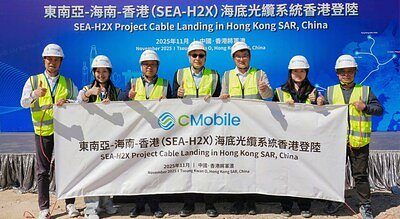
New Subsea Cable Boosts Hong Kong’s Digital Hub Status, Fuels Regional Connectivity
The SEA-H2X cable, landing in Hong Kong, significantly enhances the city’s position as a key data hub while intensifying competition and innovation in the Asia-Pacific subsea cable market.
New Subsea Cable Boosts Hong Kong’s Digital Hub Status, Fuels Regional Connectivity
Hong Kong – A new, high-capacity submarine cable system, the SEA-H2X, is poised to reinforce Hong Kong’s leading position as a vital digital hub in Asia-Pacific. Landing in Tseung Kwan O, the cable promises to enhance regional connectivity, drive economic growth, and spur innovation in the rapidly evolving data landscape.
China Mobile International (CMI) announced the completion of the cable this week, highlighting its strategic importance in connecting mainland China with Southeast Asia. However, the implications extend far beyond a simple increase in bandwidth. Industry analysts say the project is part of a larger trend of intensifying competition and technological advancements in the subsea cable market.
Hong Kong’s Strategic Advantage Reinforced
Hong Kong has long been recognized as a key data hub due to its strategic geographic location, robust infrastructure, and well-established digital ecosystem. The city serves as a crucial gateway for data traffic flowing between mainland China and the rest of the world. As demand for data continues to surge, driven by cloud computing, e-commerce, and the proliferation of data-intensive applications, the need for high-capacity, reliable connectivity becomes ever more critical.
“Hong Kong’s strength lies in its ability to act as a bridge,” says an industry consultant familiar with the project. “The SEA-H2X cable amplifies that strength, providing a direct and efficient pathway for data to flow between China and Southeast Asia. This not only benefits businesses operating in the region but also enhances Hong Kong’s attractiveness as a location for data centers and cloud services.”
According to recent market reports, Hong Kong’s data center market is experiencing robust growth, valued at $4.12 billion in 2025 and projected to reach $9.95 billion by 2030. This growth is fueled by factors such as increasing demand for cloud services, digital transformation initiatives, and the rise of AI applications. While land scarcity and power constraints pose challenges, continued investment in infrastructure like the SEA-H2X cable helps to mitigate these concerns.
A New Era of Open Cable Systems
The SEA-H2X cable is noteworthy not only for its capacity but also for its adoption of “open cable” technology. This innovative approach separates the physical cable infrastructure (the “wet plant”) from the transmission equipment (the “dry plant”), allowing operators to choose best-in-breed components from multiple vendors.
“The traditional model of turnkey submarine cable systems is giving way to a more flexible and competitive landscape,” explains a network engineer involved in the project. “Open cable systems allow operators to upgrade their networks more easily and cost-effectively, fostering innovation and reducing dependence on a single supplier.”
This move towards disaggregation is driving down costs and promoting interoperability, ultimately benefiting end-users. The SEA-H2X cable's use of open technology is aligned with a broader industry trend, as operators seek to optimize their networks and adapt to changing demands. This approach enhances network flexibility and allows for quicker upgrades to support new technologies.
Regional Connectivity and Competition
The new cable system enhances connectivity between Hong Kong, mainland China, and key Southeast Asian markets, including Singapore, Thailand, and Malaysia. This improved connectivity will facilitate cross-border trade, investment, and collaboration, boosting economic growth in the region.
However, the arrival of SEA-H2X also intensifies competition among subsea cable operators. Singtel, NTT, and Reliance Jio are all actively investing in new cable systems, vying for market share and seeking to expand their regional footprints.
“The competition is fierce, and that’s a good thing for consumers,” says a telecom analyst. “Operators are constantly pushing the boundaries of technology to deliver faster, more reliable, and more affordable connectivity. This is driving innovation and benefiting businesses and consumers alike.”
NTT, for example, is commissioning the MIST cable system, connecting Malaysia, India, Singapore, and Thailand, while Singtel is involved in multiple consortia building new cables across the region, including the Asia Direct Cable (ADC) and the Asia Link Cable System (ALC). Reliance Jio is focusing on India-centric submarine cable systems like the India-Asia-Xpress (IAX) and the India-Europe-Xpress (IEX).
Looking Ahead: Challenges and Opportunities
Despite the positive outlook, several challenges remain. The cost of building and maintaining subsea cable systems is substantial, and operators must carefully manage their investments. Geopolitical risks, such as cable damage due to accidental or intentional interference, also pose a threat.
“Protecting subsea cable infrastructure is crucial,” warns a cybersecurity expert. “Operators must invest in robust security measures to mitigate risks and ensure the resilience of their networks.”
Nevertheless, the opportunities for growth and innovation are immense. The demand for data is expected to continue to surge in the years to come, driven by emerging technologies such as 5G, IoT, and AI. Subsea cable systems will play a vital role in supporting this growth, providing the essential infrastructure for a connected world.
The SEA-H2X cable is a significant step forward in enhancing regional connectivity and solidifying Hong Kong’s position as a leading digital hub. By embracing open technology and fostering competition, the project paves the way for a more connected, innovative, and prosperous future.
📝 This article is still being updated
Are you a relevant expert who could contribute your opinion or insights to this article? We'd love to hear from you. We will give you full credit for your contribution.
Contribute Your Expertise →